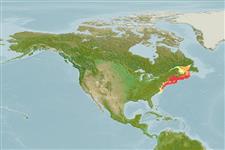Classification / Names
Common names from other countries
Main reference
Tamaño / Peso / Age
Max length : 66.0 cm TL macho / no sexado; (Ref. 40637); peso máximo publicado: 3.6 kg (Ref. 40637)
Length at first maturity
Lm 26.0 range ? - ? cm
Medioambiente
; marino demersal; oceanodromo (Ref. 51243); rango de profundidad 35 - 1152 m (Ref. 57178), usually 110 - 130 m
Clima / Gama
Temperate, preferred 9°C (Ref. 107945); 51°N - 33°N, 79°W - 58°W
Distribución
Short description
Espinas dorsales (total): 0; Espinas anales 0. First dorsal fin ray elongated. Pelvic fins also reaching about the anal fin origin. Body color variable, reddish to olive brown dorsally, sometimes very dark or mottled; lower sides paler, sometimes with dusky dots; belly and underside of the head pale. A dusky blotch present on the opercle. The fins are generally dark, except for the pelvic fins, which are pale.
IUCN Red List Status (Ref. 115185)
Threat to humans
Harmless
Human uses
Pesquerías: comercial; pesca deportiva: si
Herramientas
Special reports
Download XML
Fuentes de Internet
Estimates of some properties based on models
Phylogenetic diversity index
PD50 = 0.5044 many relatives (e.g. carps) 0.5 - 2.0 few relatives (e.g. lungfishes)
Nivel trófico
3.7 ±0.3 se; Based on diet studies.
Resiliencia
Medio, población duplicada en un tiempo mínimo de 1.4-4.4 años (K=0.19; tm=2-3)
Vulnerability
Moderate to high vulnerability (51 of 100)
Price category
